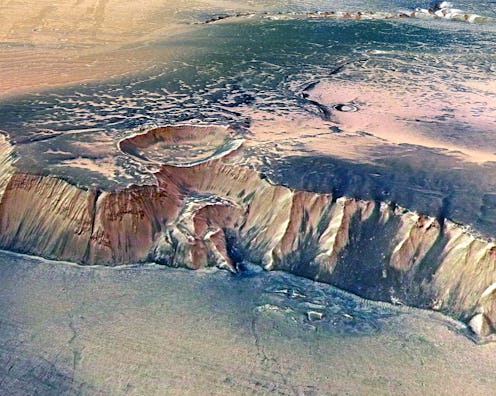Life
Scientists Found Actual Liquid Water On Mars & It’s Kind Of A Big Deal

The news cycle has been full of Liquid News (yes, capitalization necessary) lately, from the mysterious sarcophagus goop to new research showing the moon may be wetter than previously expected to the most exciting news of all: It looks like there's an actual lake on Mars. We already knew liquid water flows intermittently on Mars' surface, but the discovery that there is a possible lake on Mars opens the door for all sorts of new discoveries, including the astrobiological goldmine: conclusive evidence that we are not alone.
By using the MARSIS (Mars Advanced Radar for Subsurface and Ionosphere Sounding) to take 29 scans between May 2012 and December 2015, researchers were able to determine that there's likely a 20 kilometer-wide body of water under the ice of Mars' South Polar Layered Deposits, according to the study report, published July 25 in the journal Science. They can't conclude exactly how large it is, but Roberto Orosei, a professor from the Italian National Institute for Astrophysics and the lead author on the study, told the BBC he and his team estimated it's at least one meter deep.
"[That depth] really qualifies this as a body of water," Orosei said. "A lake, not some kind of meltwater filling some space between rock and ice, as happens in certain glaciers on Earth."
What's more, the researchers don't think this is the only body of water on Mars. Because MARSIS can only detect patches of liquid that are "several kilometers in diameter and several tens of centimeters in thickness," per the study report, researchers concluded that there is "no reason [...] that the presence of subsurface water on Mars is limited to a single location."
The reason scientists previously thought standing bodies of water on Mars weren't likely is because Mars has cooled since its formation, "leaving most of its water locked up in ice," the BBC reported. But if water on Mars is subsurface, that may actually turn out to be a good sign for potential life on the planet. Dr. Manish Patel of Open University told the BBC, "We have long since known that the surface of Mars is inhospitable to life as we know it, so the search for life on Mars is now in the subsurface."
Patel explained that organisms potentially living in subsurface environments would be protected from radiation, and would also be living in "more favourable levels" of atmospheric pressure and temperatures. "Most important, this allows liquid water, essential for life," he added.
Putting a bit of a damper on things, Patel said that as of this moment, we're not any closer to finding life out there in the universe. However, "what this finding does is give us the location of where to look on Mars," he told the BBC. "It is like a treasure map — except in this case, there will be lots of 'X's marking the spots."
And Orosei and his team found one big X. As with all potentially groundbreaking scientific experiments and discoveries, this one will need to be double-checked through repetition, which means we laypeople aren't likely to get a definitive Mars Water answer for another few years. But in the meantime, we can at least be assured that somewhere, possibly even on Mars, the truth is out there.